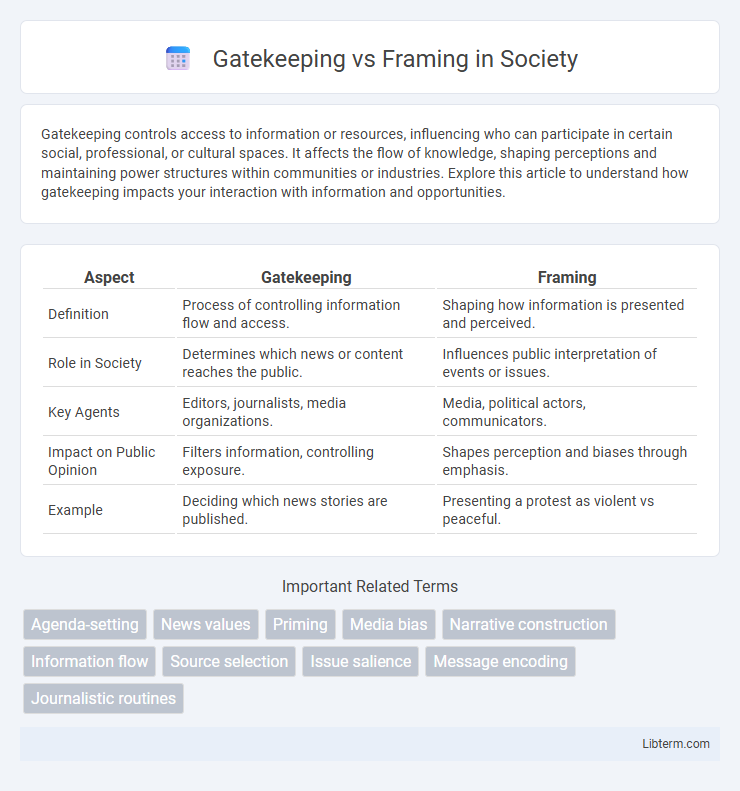Gatekeeping controls access to information or resources, influencing who can participate in certain social, professional, or cultural spaces. It affects the flow of knowledge, shaping perceptions and maintaining power structures within communities or industries. Explore this article to understand how gatekeeping impacts your interaction with information and opportunities.
Table of Comparison
| Aspect | Gatekeeping | Framing |
|---|---|---|
| Definition | Process of controlling information flow and access. | Shaping how information is presented and perceived. |
| Role in Society | Determines which news or content reaches the public. | Influences public interpretation of events or issues. |
| Key Agents | Editors, journalists, media organizations. | Media, political actors, communicators. |
| Impact on Public Opinion | Filters information, controlling exposure. | Shapes perception and biases through emphasis. |
| Example | Deciding which news stories are published. | Presenting a protest as violent vs peaceful. |
Understanding Gatekeeping in Media
Gatekeeping in media refers to the process by which information is filtered and selected for dissemination, shaping public knowledge by determining what content reaches audiences. Editors, journalists, and media organizations act as gatekeepers by deciding which stories are newsworthy, influencing public perception and agenda-setting. This process impacts the diversity of viewpoints presented, affecting how societies understand events and issues.
The Concept of Framing Explained
Framing refers to the process by which media and communicators select certain aspects of a perceived reality to emphasize, shaping how audiences interpret events and issues. It involves highlighting particular themes, narratives, or perspectives to influence opinions and attitudes. Unlike gatekeeping, which controls access to information, framing shapes the meaning and context in which information is understood.
Key Differences Between Gatekeeping and Framing
Gatekeeping determines which information is selected and filtered for public consumption, controlling the flow of content based on editorial policies or social norms. Framing shapes how the selected information is presented and interpreted by emphasizing certain aspects, influencing audience perception and understanding. While gatekeeping controls access to information, framing molds the meaning and context surrounding that information.
Historical Development of Gatekeeping Theory
Gatekeeping theory, originally developed by Kurt Lewin in the 1940s, examines how information is filtered as it moves through communication channels, shaping public perception. Early research focused on the role of individual decision-makers, such as news editors, who control the flow of information to audiences. Over time, the theory evolved to incorporate broader social and technological factors influencing gatekeepers in media organizations.
Evolution of Framing Theory in Communication
Framing theory in communication evolved from gatekeeping by shifting focus from controlling information access to shaping how audiences perceive and interpret messages. Early gatekeeping emphasized the filtering of news, while framing analysis examines the constructed context and narrative frames that influence public opinion and meaning-making. This evolution highlights the dynamic roles of media in not only selecting content but also framing social reality through linguistic and visual cues.
Impact of Gatekeeping on Public Perception
Gatekeeping controls the flow of information by selecting which news stories reach the public, significantly shaping public perception through agenda-setting. This process influences which issues people consider important by highlighting certain events while omitting others, creating a filtered reality. The selective exposure resulting from gatekeeping can lead to biased or incomplete understanding, directly affecting opinions and social attitudes.
How Framing Shapes Audience Interpretation
Framing shapes audience interpretation by selectively highlighting certain aspects of a message, influencing how information is perceived and understood. It directs attention to specific details, contexts, or perspectives, which can alter the emotional and cognitive response of the audience. Unlike gatekeeping, which controls what information is presented, framing controls how that information is presented, thereby shaping meaning and influencing public opinion.
Gatekeeping and Framing in the Digital Age
Gatekeeping in the digital age involves controlling the flow of information through algorithms, platform moderation, and content curation, shaping what users see and engage with online. Framing influences how digital news and social media present information, affecting public perception by highlighting specific aspects or narratives. Together, gatekeeping and framing digitally transform news consumption, impacting user awareness, opinion formation, and information diversity.
Real-World Examples: Gatekeeping vs Framing
Gatekeeping controls the flow of information by deciding what news stories reach the public, as seen in editorial choices in major news outlets filtering sensitive political content. Framing shapes how these stories are presented, influencing public perception through specific language or angles, like emphasizing economic benefits in immigration reports. Real-world examples include coverage of election campaigns where gatekeepers select which candidates are featured, while framers highlight particular policy issues to sway voter opinion.
Implications for Media Literacy and Society
Gatekeeping controls the flow of information by selecting which news stories reach the audience, shaping public perception by filtering content based on editorial priorities. Framing influences how information is interpreted by emphasizing certain aspects, affecting audience attitudes and societal norms through the presentation of specific narratives. Understanding both processes enhances media literacy, enabling individuals to critically analyze media messages and resist manipulation, thereby fostering a more informed and engaged society.
Gatekeeping Infographic

 libterm.com
libterm.com